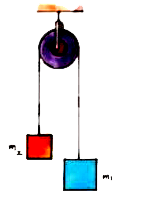Atwood machine

Atwood used the system to prove Netwons laws of motion. Atowood machine consists of two loads of mases m1andm2 attached to the ends of a limp of inextensible string as shown in tghe figure 11. The string runs over a pully. FInd the acceleration of each load and tension in the string (m1>m2) Solution in Telugu
we know that tension of string always tries to pull te bodies up.

From the FBD of the mass m1, there exist two forces on the load of mass m1, one is tension of the string acting in upward direction and weight of the load (m1g) acting in downward direction.
The net force on m1Fnet=m1a
⇒m1g−T=m1a−−−−−−−−−−−−−−−(1)
Thus the net force (Fnet) acting on mass m1 produces an acceleration .a. in it.
When m1 moves down, m2 moves up. So the magnitudes of acceleration are same.

From the FBD of mass m2
Fnet=T−m2g=m2a−−−−−−−−−−−−−−−−(2)
Solving (1) and (2) equations, we get
a=(m1−m2gm1+m2
T=2m1m2gm1+m2
Topper's Solved these Questions
- LAW OF MOTION BOOK - NCERT TELUGUCHAPTER - LAW OF MOTION EXERCISE - THINK AND DISCUSS
12 Videos
- LAW OF MOTION BOOK - NCERT TELUGUCHAPTER - LAW OF MOTION EXERCISE - LET US IMPROVE OUR LEARNING (REFLECTIONS ON CONCEPTS )
3 Videos
- GRAVITATIONBOOK - NCERT TELUGUCHAPTER - GRAVITATIONEXERCISE - Improve your learning
13 Videos
- LAWS OF MOTIONBOOK - NCERT TELUGUCHAPTER - LAWS OF MOTIONEXERCISE - IMPROVE YOUR LEARNING
6 Videos
Similar Questions
You may have seen the trick where a tablecloth is jerked from a table, leaving the dishes that were on the cloth nearly in their original positions.
What do you need to perform this successfully?
Which cloth should we use? Is it cloth made of thick cotton or thin silk?
Should the dishes possess large mass or small mass?
Is it better to pull the cloth with a large force or pull it with a gentle and steady force?
View SolutionExplain the reasons for the following (AS1)
(a) Why dust comes out of carpet when it is beaten with a stick ?
(b) Laggage kept on the roof of a bus is tied with a rope.
(c ) Why a pace bowler in cricket tuns from a long distance before he bowls ?
View SolutionA car moves with constant speed of 10 m/s in a circular path of radius 10m. The mass of the car is 1000 kg. Who or what is providing the required centripetal force for the car? How much is it?
View SolutionWhat is the momentum of a 6.0 kg bowling ball with a velocity of 2.2 m/s?
View SolutionThe block shown in figure has a mass M and descends with an acceleration a. the mass of the string below the point A is m. Find the tension of the string at the point A and at the lower end.

View SolutionA body of mass M is hanging by an inextensible string of mass m. If the free end of the string accelerates up with constant acceleration a. find the variation of tension in the string a fuction of the distance measured from the mass M (bottom of the string).
View SolutionSimple Atwood Machine as System of Particles The system shown in the figure is known as simple Atwood machine. Initially the masses are held at rest and then let free. Assuming mass m_(2) more than the mass m_(1) , find acceleration of mass center and tension in the string supporting the pulley.
View SolutionTwo masses M and m are connected at the two ends of an inextensible string. The string passes over a smooth frictionless pulley. Calculate the acceleration of the masses and the tension in the string. Given Mgtm .
View SolutionIn an atwood machine the two blocks have massess 1kg and 3kg . The pulley is massless and frictionless and string is light. The acceleration of the centre of mass (in m//s^(2) ) of this system is 0.5x . Find the value of x .
View SolutionTwo masses m and M are attached to the strings as shown in the figure. If the system is in equilibruim, then
View SolutionTwo masses m and M are attached to the strings as shown in the figure. If the system is in equilibrium, then
View SolutionThe masses M and m connected to the two ends of an inextensible string. The string passes over a smooth frictionless pulley. Calculate the acceleration of the masses and the tension in the string. Given, M gt m .
View SolutionTwo masses (M+m)and(M−m) are attached to the ends of a light inextensible string and the string is made to pass over the surface of a smooth fixed pulley. When the masses are released from rest, the acceleration of the system is
View SolutionTwo bodies of masses m and M are attached to the two ends of a light string passing over a fixed ideal pulley (M gt gt m) . When the bodies are in motion, the tension in the string is approximately
View SolutionAtwood machine

Atwood used the system to prove Netwons laws of motion. Atowood machine consists of two loads of mases m1andm2 attached to the ends of a limp of inextensible string as shown in tghe figure 11. The string runs over a pully. FInd the acceleration of each load and tension in the string (m1>m2)
View Solution
